2006 AALS Meeting, Jan. 6, Section on Art Law
Art Law and Intellectual Property Law: Convergence and Conflict
Cyrill P. Rigamonti, a research fellow at Harvard’s Berkman Center, spoke about net art and the theory of moral rights. He used the example of Cornelia Sollfrank, a German artist who commissioned a program called the net art generator. It creates pictures based on Google search results. You type in a search term; the program finds 4-8 matching pictures and manipulates them in various ways, with an element of randomness. The result is a composite picture plus information about the source pictures. Because of the random elements, the chance of creating the same picture twice is quite low. Sollfrank entered the same term again and again to create a themed set of pictures. She wanted to show a room full of the printed-out results, but the art gallery she worked with refused, because her pictures seemed to be unauthorized derivative works of Andy Warhol’s Flowers.
Andy Warhol's Flowers:

Rigamonti showed a picture of one of her results, and that seemed like an accurate characterization to me. I tried "Warhol flowers" at the art generator myself. The version I used, net art generator #3, allowed users to select 2, 4, 6 or 8 source pictures; this first set used 8:
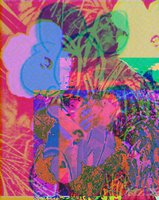

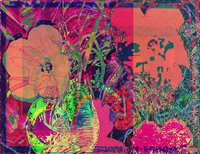
Using 2 images instead produced these results:
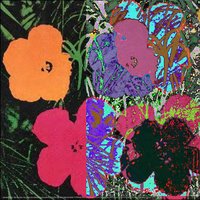

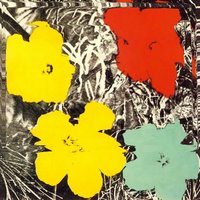
Though it's hard to see in the small version, that third has some neat distortion, but they're all pretty recognizably based on Warhol's Flowers.
Warhol himself used Patricia Caulfield’s photo of flowers without permission to create his works; he settled the resulting copyright suit for $6000 in royalties (rejecting Warhol’s offer of 2 paintings instead; bad decision, or principled one?). Warhol also gave silkscreens to the appropriation artist Elaine Sturtevant, who used them to create works called “Warhol Flowers”; he apparently believed that she knew more about his technique than he did.
Sturtevant's Johns Flag (I couldn't find a picture of her Warhol Flowers):
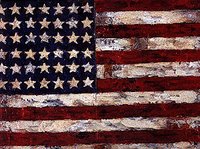
Sollfrank’s response to the gallery’s concerns was to videotape four interviews with copyright lawyers reacting to the issue and showed them on four different screens for her exhibit, creating a babble effect.
Are such pictures derivative works? They were created by machines, thus perhaps lacking the necessary creative addition to qualify as independently copyrightable derivative works. Or perhaps we need some concept of co-authorship with the person who enters the search terms and the person who wrote the program.
According to Rigamonti, Sollfrank’s work challenges the theoretical foundation of moral rights – the claim that works embody an author’s personality or personhood. What are the functions of moral rights, and how should we think about them in the digital age? (1) Art preservation – though Germany doesn’t use moral rights for this purpose, as graffiti artists found out when they couldn’t protest the destruction of the painted Berlin Wall. (2) Copyright substitution, to allow continued authorial control if the author transfers economic rights. (3) Setting default or mandatory terms in copyright contracts; this matters if the accused infringer of moral rights is the copyright owner.
Rigamonti suggests that we should rethink these foundations, and particularly that we should examine how moral rights are used in practice instead of trying to cram all these objectives into one theory. Though I agree with this conclusion, I have to admit, I’m not too clear on how Sollfrank’s work operates as a challenge to moral rights: It seems like a devout moral rights proponent would be able to say that what she does isn’t art and therefore, though it can violate artists’ moral rights like any form of defacement, it can’t make competing claims to protection for Sollfrank’s personhood.
No comments:
Post a Comment